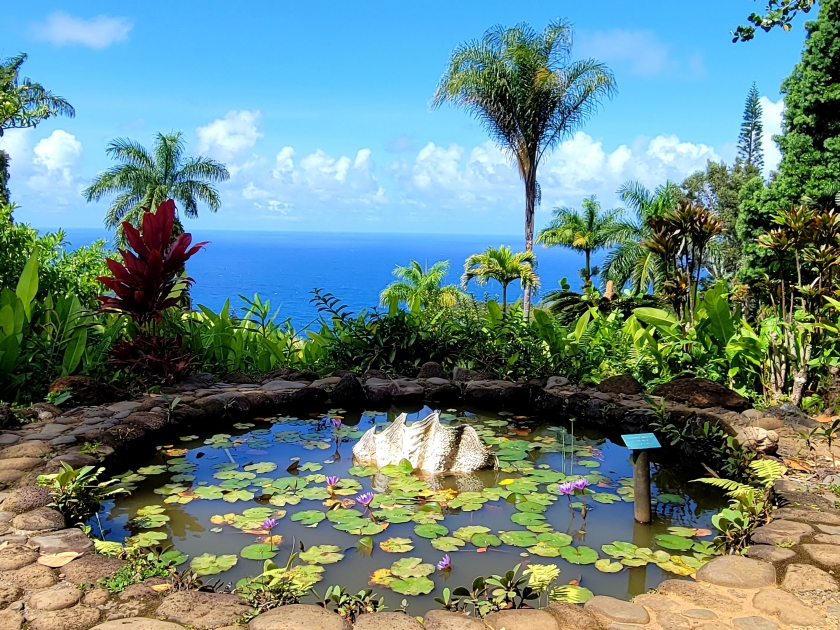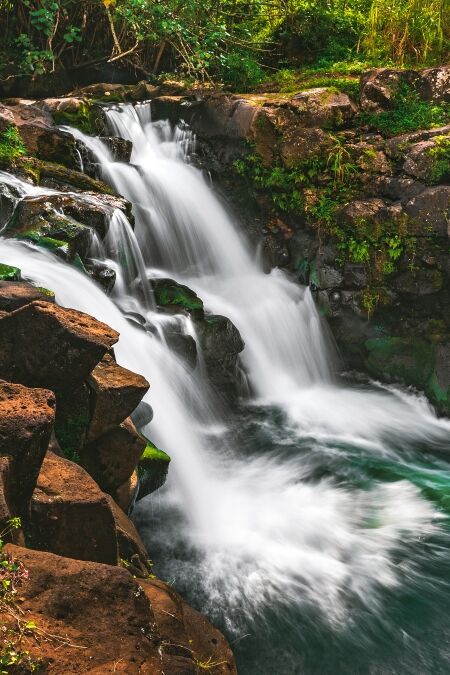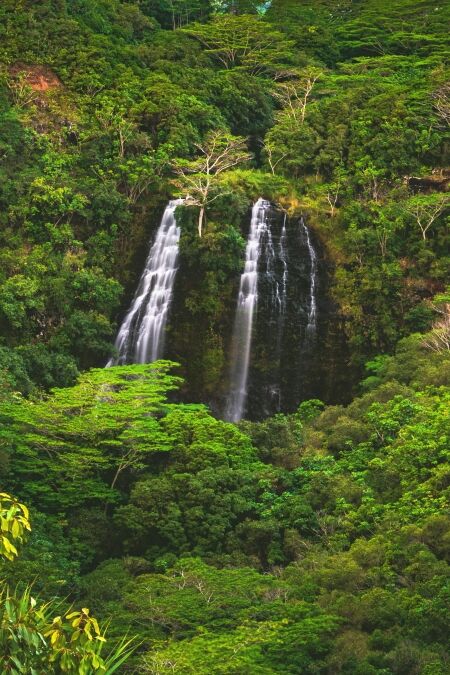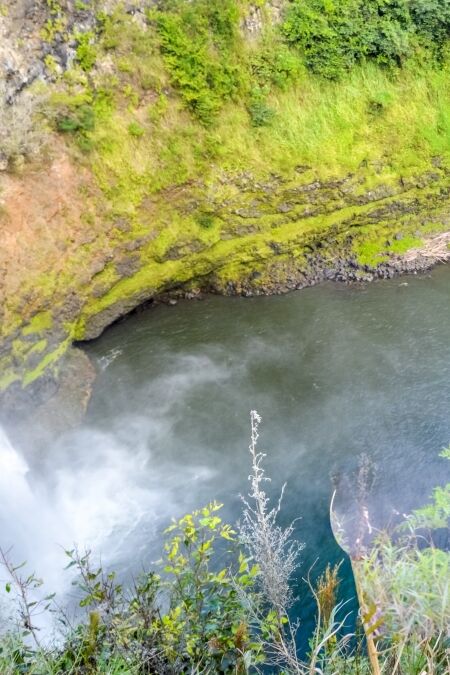Located along Maui’s iconic Road to Hana, Upper Waikani Falls, also called Three Bears Falls, is a mesmerizing natural gem that leaves visitors in awe with its striking beauty. This guide will provide everything you need to know to fully enjoy your visit and make the most of your time at this enchanting waterfall.
Highlights
- Located along the famous Hana Highway, this waterfall is easily accessible by car, making it a perfect quick stop without requiring a long hike. You can view the falls from the road or take a short climb down for a closer look.
- The pool at the base of the falls is a popular swimming spot, where visitors can take a refreshing dip in cool, clear water.
- The area around Upper Waikani Falls is surrounded by vibrant tropical greenery, offering a peaceful and serene atmosphere for those looking to immerse themselves in nature.
- Upper Waikani Falls can be a quick stop for travelers on a tight schedule or a place to linger for a while, enjoying the scenery and tranquility, making it flexible for any itinerary.
History

Upper Waikani Falls is a breathtaking three-tiered waterfall located along the iconic Road to Hana in Maui, Hawaii. Each tier of the falls—affectionately named Papa Bear, Mama Bear, and Baby Bear—cascades down a cliff, creating a mesmerizing sight as they flow into a crystal-clear pool below. This natural wonder has become a must-see attraction for travelers seeking both scenic beauty and a serene atmosphere.
Geological and Natural Features
The formation of Upper Waikani Falls is a result of millions of years of volcanic activity and water erosion. As lava flows solidified over time, they created deep valleys and gorges, which were later sculpted by streams. The three distinct tiers of the waterfall are likely due to the varying hardness of the rock layers in the area. The region’s annual rainfall, ranging from 100 to 300 inches, ensures a consistent flow of water and can transform the falls into a powerful cascade during heavy rains.
Cultural and Historical Significance
Upper Waikani Falls is part of an ancient ahupua’a, a traditional Hawaiian land division that extends from the mountains to the sea. The land around the falls once played a vital role in sustaining local Hawaiian communities, particularly through the cultivation of taro (kalo), a staple crop that remains significant in traditional Hawaiian cuisine today. The surrounding area, known as Wailua Nui, was renowned for its fertile land and abundant resources. Some accounts suggest that Captain James Cook, during his voyages to the Hawaiian Islands in the 18th century, may have anchored his ship near the region, although this remains speculative. The name “Three Bears Falls” is a playful reference to the children’s tale Goldilocks and the Three Bears, with each of the three cascades symbolizing different-sized bears.
Visiting Upper Waikani Falls Today
Today, Upper Waikani Falls remains largely untouched by commercial development, allowing visitors to experience its natural beauty in an authentic and peaceful setting. Its location along the Road to Hana makes it easily accessible, requiring only a short scramble from the roadside to reach the base of the falls. While there is limited parking, the slight effort to access the falls adds to the sense of seclusion and tranquility. The clear pool at the bottom of the falls invites travelers to take a refreshing swim, making it a perfect spot to cool off during the journey along the Road to Hana.
What to Expect

Upper Waikani Falls offers scenic views surrounded by vibrant greenery, creating the perfect backdrop for photos. It’s an ideal spot to pause and relax, letting the peaceful sounds of nature wash over you. While there, keep an eye out for local wildlife that thrives in the lush environment, adding to the charm of this serene location.
The Waterfall Experience

The Waterfall Experience: Upper Waikani Falls is a three-tiered waterfall, earning the nickname “Three Bears” for its small, medium, and large cascades. You can admire the falls from the road or hike down for a closer look, though the path can be steep and slippery. The water is often clear, making it a refreshing swimming spot, but exercise caution due to rocks and swift currents. The best time to visit is during the dry season, as heavy rains can increase water flow and make the area more dangerous.
Safety and Accessibility
Hiking down to Upper Waikani Falls can be challenging, especially after rain, as the rocks become slippery and the incline steep. Exercise caution if you choose to swim, as the water currents can be strong, and the rocks around the falls are uneven. For families or those with mobility concerns, the falls can still be enjoyed from a safe viewing point on the road, offering a beautiful vantage without the need for a difficult hike.
What to Bring
Be sure to pack essentials like water shoes for navigating the slippery rocks, swimsuits and towels if you plan to swim, as well as sunscreen and bug spray for comfort. Don’t forget your camera—mornings and early afternoons offer the best lighting for capturing the falls, and positioning yourself slightly downstream can provide stunning wide-angle shots of all three cascades.
Best Times to Visit
The best time to visit Upper Waikani Falls is during the dry season, from spring through early fall, when the weather is more predictable, and water flow is moderate. Mornings offer fewer crowds and softer lighting for photos, while afternoons may bring more visitors but still provide a stunning view. Avoid visiting right after heavy rain, as the trail can become slippery and hazardous, and the water flow can be too strong for safe swimming.
Nearby Attractions

While visiting Upper Waikani Falls, make the most of your trip by exploring nearby stops along the Hana Highway. Check out Puaʻa Kaʻa State Wayside Park for scenic trails, Wailua Valley State Wayside for panoramic views, and the Garden of Eden Arboretum to discover lush botanical gardens. You can also combine your visit with a day trip to Hana, where you’ll find even more natural wonders, including Wailua Falls, Venus Pool (Waioka Pond), and the famous Black Sand Beach.
Frequently Asked Questions (FAQs)
Swimming at Upper Waikani Falls can be risky due to strong currents and slippery rocks. It’s essential to assess conditions before entering the water.
It takes approximately 45 minutes to drive from Kahului to Upper Waikani Falls, depending on traffic and road conditions.
No, there are no restrooms or facilities directly at Upper Waikani Falls, so plan for your visit.
Parking is limited near Upper Waikani Falls, with only a few roadside spots available. Exercise caution when parking along the road.
Upper Waikani Falls requires a short but steep climb to access, which may not be suitable for those with mobility issues.
No permit is required to visit Upper Waikani Falls, but visitors should always respect the natural surroundings and follow posted signs.
How to Get There
To reach Upper Waikani Falls, take the Hana Highway from Kahului or Paia, following the scenic drive east. The falls are located between mile markers 19 and 20, just past other notable stops like Twin Falls. Parking can be tricky, as only a few roadside pull-offs are available, so it’s best to arrive early to avoid crowds. Be sure to pull completely off the road for safety. If you want a closer view of the falls, you can hike down from the road, but the path can be steep and slippery.
From Road to Rushing Waters
Upper Waikani Falls, with its mesmerizing three-tier cascade, is a must-see on any Road to Hana journey. Its stunning natural beauty offers a perfect pause to soak in Maui’s tranquil landscapes. Whether you’re viewing from the road or hiking closer, this waterfall promises a magical experience. Remember to tread lightly and respectfully, ensuring that future travelers can enjoy the same pristine wonder.




